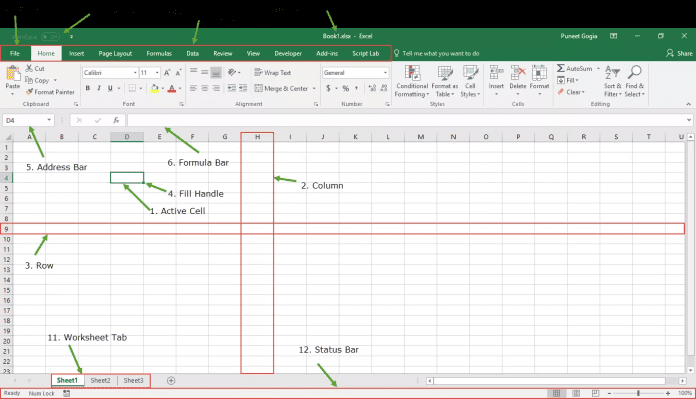Before attending a job interview, you must have a basic understanding of Microsoft Excel. From accountants to receptionists, and from human resources to administration, everyone uses Microsoft Excel.
Introduction of Microsoft Excel
Excel is a spreadsheet program that records and analyzes numerical and statistical data. Microsoft Excel has a lot of tools for doing different things, like calculations, pivot tables, graphing tools, programming macros, etc. It is compatible with multiple operating systems, including Windows, macOS, Android, and iOS.
A spreadsheet in Excel is a collection of columns and rows that form a table. Columns are usually assigned alphabetical letters, and rows are generally set numbers. A cell is the intersection of a column and a row. A cell’s address is determined by the letter representing the column and the number representing the row.
Following are the few things which MS Excel can do for you:
- Store and Import Data
- Charts and Graphs
- Number Crunching
- Manipulating Text
- Automation of Tasks
- Templates/Dashboards
- Financial Report Data Store
- And Much More…
Most Important Components of MS Excel
Cell
A cell is the most basic and essential component of any spreadsheet. Data in a cell can be entered manually or via copy-and-paste. Information can be in the form of text, numbers, or dates. It’s fully modifiable, down to the pixel; just pick a new size, typeface, background color, and border style. Cell addresses consist of the cell’s row and column information, uniquely identifying each individual cell (If a cell is on the 11th row and on column AB, then its address will be AB11).
Worksheet:
Each cell in a worksheet can store a number, a formula, or some type of textual or graphical data. In addition, it has a hidden draw layer where you can store things like diagrams and charts. You can switch between the various worksheets in a workbook by using the tabs along the bottom of the window. A workbook can also keep track of chart sheets, where each tab displays a different chart.
Workbook:
A workbook, like the files used by other programs, is stored in its own dedicated folder. There are one or more sheets in each workbook. In another sense, a workbook is just one large worksheet, or it can contain many smaller ones. Worksheets can be added or removed, hidden from view without being deleted, and rearranged within a workbook.
Active Cell : Active Cell selected by the click of mouse, bounded by a frame.
Address of the cell: Address is the name of the cell. The address contains of a column and row names, such as the A3 (the address of the cell that is at the intersection of column A and row 3). Each cell has its specific address, which is a unique address in the same worksheet.
Functions and Formulas: all formulas that evaluate the value based on the data from cells.
Range: Range is a group of cells. Range in MS Excel can be: cells in one column, for example, B3: B8, cells in one line, for example, A3: G3, cells with some columns and rows, e.g. C1: H9.
Format: the appearance of the data, the way they are presented in a cell or range of cells. Format involves of for example style (Bold, italic), border, background, text alignment, etc.
Column: A column is a vertical collection of cells. A single worksheet has a total of 16384 columns. Each column has its own identity alphabet, ranging from A to XFD. Clicking a column’s header will select that column.
Row: A row is a horizontal collection of cells. A single worksheet contains a total of 1048576 rows. Each row has its own unique identity number, ranging from 1 to 1048576. You can select a row by clicking on the row number on the window’s left side.
Title Bar: The name of your workbook and the name of the program (“Microsoft Excel”) will be shown in the title bar.
File Menu: The file menu is just a simple menu, just like the menus in all other programs. It has options such as (Save, Save As, Open, New, Print, Excel Options, Share, etc).
Quick Access Toolbar: A toolbar that lets you get to the options you use most often quickly. By adding new options to the quick access toolbar, you can add your favorite options.
Fill Handle: It’s a small dot in the lower right corner of the active cell. It lets you fill in numeric values, text series, ranges, serial numbers, and other things.
Address Bar: This shows the cell’s address. If you choose more than one cell, the address of the first cell in the range will be shown.
Formula Bar: The formula bar, which is below the ribbon, is an input bar. It shows the content of the active cell and can also be used to enter a formula in a cell.
Ribbon: Ribbons have replaced all the options menus in Microsoft Excel since 2007. Ribbon tabs are made up of a group of specific options, each of which is then made up of a set of options.
Status Bar: This is a thin bar at the bottom of the Excel window. It will help you right away when you start to use Excel.




